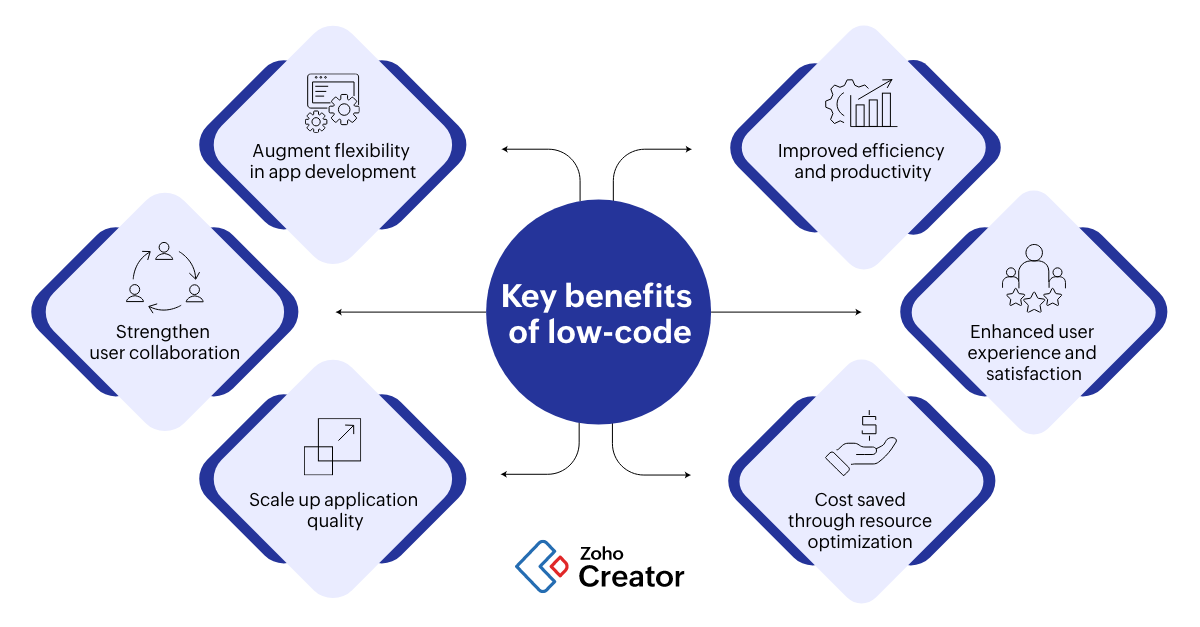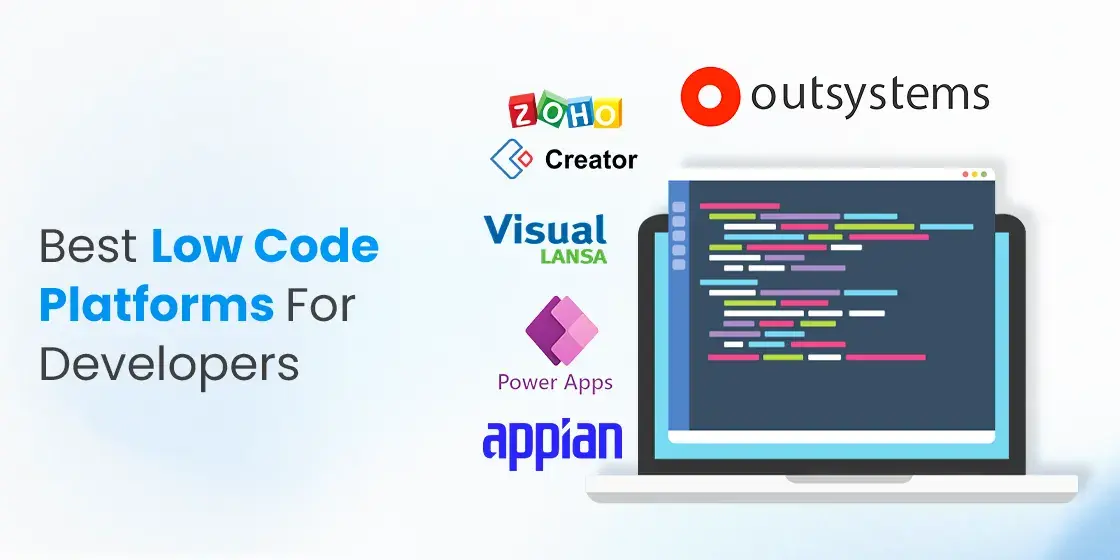Top Reasons For Picking Legacy application modernization with Low-code
Top Reasons For Picking Legacy application modernization with Low-code
Blog Article
Advantages Of Low-Code Application Development With Regard To Accessibility For Non-Developers
Low-code applications greatly improve accessibility for non-developers. Often, they are referred to as "citizen developers" because of several important factors: Intuitive Visual Interfaces:
Drag-anddrop Builders: Lowcode platform have drag-and-drop interfaces that enable non-developers to create visually appealing applications, without having to code. This makes it much easier for those with less technical expertise to be involved in the process of development.
WYSIWYG editor: The "What you see is the result you will get" editors let users design interfaces, workflows, and other functions in a manner that is similar to the final result. They are easier to comprehend and use.
Simplified Design of Logic and Workflow
Visual Workflow modeling: Users create business processes and application logic with visual flowcharts. These models are simpler to use than conventional codes.
Pre-built Components of Logic Low-code platforms typically include already-built logic (e.g. loops, conditional statement) which can be easily set up, eliminating the requirement for complicated programming.
Reusable Components and Templates:
Libraries of pre-built templates: A lot of low-code platforms provide templates for common applications which allow non-developers to start with a solid foundation to customize as needed.
Reusable widgets and modules The creation of websites is made easier by using reusable components as well as modules. This means that there is less necessity for a deep technical understanding.
Tutorials and Guided Development
Step-by-Step instructions Platforms typically offer tutorials that are on screen, guided development paths and other tools that help developers who are not developers create apps.
Interactive Tutorials - Interactive tutorials which let you interact with the platform can help you learn and gain confidence.
Integration with tools already in use:
Seamless Integrate: Low code platforms are built to integrate seamlessly with the existing systems and tools within business (e.g. the ERP or CRM) that allows non-developers, to create applications that work with current workflows.
APIs Connectors: APIs are built into apps to facilitate integration. This allows non-programmers who don't have programming skills, to connect with external services.
Collaboration Features:
Team Collaboration: Features such as real-time collaboration and shared workspaces allow non-developers to collaborate with business analysts, professional developers and other stakeholders efficiently.
Access Control Based On Roles: Users who do not develop can be assigned roles and access levels that permit them to contribute without compromising functionality or security.
Automated testing and debugging
Built-In Testing Tools: Low-code platforms usually come with built-in testing and debugging tools that can automate these procedures, making it much easier for non-developers and users to ensure that their applications work correctly.
Error Highlighting Whenever errors are detected the platform highlights these and offers possible solutions. It assists non-developers with solving the issue.
Overall, the main advantage of low code application development for non-developers is in its ability to democratize the development process. Low-code platforms are easy to use, visual tools, guided experiences, and let business users actively participate in creating, maintaining and updating applications. Follow the top rated Low-code Platform for application development for site advice including software for app development, push notifications android, paas service, rapid action development, rad application development, multiplatform mobile app development, cross platform mobile app development, rad application development, mobile app development platforms, build a docker container and more.
Benefits Of Low-Code Application Development In Terms Of Flexibility And Scalability
Low-code applications offer several advantages in terms of scalability. They are flexible and able to be adjusted to accommodate new needs. Here are a few of the main benefits rapid scaling:
Cloud-Based Platforms: A large number of platforms that are low-code-friendly are cloud-based. They allow applications to easily scale up and down with the cloud infrastructure. This allows companies to handle increased workloads without having to be concerned about managing servers.
Auto-Scaling: This feature will automatically adjust the resources in accordance with the demand. This guarantees the same performance even during peak hours with no manual intervention.
Flexible Architecture:
Modular Application Design: A low-code platform promotes modular application design. Components can be independent developed, tested and increased in size. This modularity is a great method to improve flexibility. It can also be used to update and expand parts of an application without having to have the entire application affected.
Microservices integration: The support offered by the microservices architecture enables applications to be developed as a collection loosely linked services. This increases capacity and flexibility.
Customizable Options:
Extensibility. Low-code platforms typically allow the creation of custom scripts or coding. Developers can enhance the capabilities of the software beyond what is offered in the standard package. This allows companies to meet their specific requirements.
Third-Party Integrations: The incorporation of APIs, third-party services or other types of services permits companies to expand the capabilities of their application by adding additional functionalities.
Agile Development and Deployment
Continuous Delivery and deployment: Low-code platforms are compatible with agile methodologies and enable continuous integration and delivery (CI/CD). This allows applications to be upgraded and upgraded rapidly and in response to feedback from users.
Iterative Development: Because of the iterative nature low-code software can grow and evolve gradually. This reduces the potential risk of major changes and allows for greater control over expansion.
Resource Optimization
Efficient Resource management: Low-code platform tools help optimize resource use by monitoring and managing performance of software. They ensure that resources are utilized effectively and efficiently scaled up or back down in accordance with the needs of the moment.
Load-balancing: The program can handle high traffic efficiently and with a high degree of consistency due to the load-balancing capabilities.
Global Reach:
Multi-Region Implementation: Low code platforms can be deployed across multiple geographical regions. This allows companies to provide users with low latency internet access across the globe. This is particularly important when applications have a large global user base.
Localization Support The built-in support for language localization allows applications to be easily adapted for different languages and regional needs which allows them to adapt to diverse markets.
Maintenance and Updates:
Low-code applications are visually and modularly designed, which makes it easy to do maintenance. Updates and bug fixes can be completed quickly and without lengthy downtime.
Version Control: The integrated Version Control System helps to control changes and roll backs. This ensures that updates can be easily implemented and earlier versions restored when needed.
Cost Efficiency:
Low Development Costs: By reducing the amount of coding needed, low-code platforms can cut down on development costs. This allows to expand applications without increasing development efforts and expenses.
Pay-As-You-Go Models - A lot of low-code applications have flexible pricing models such as pay-as you-go that is based on the actual usage, growth, and financial flexibility.
In the end, low-code application development gives businesses the flexibility and scalability they need to build robust and flexible apps. These platforms provide quick responses to changing requirements, resource efficiency, and continual improvements, making it possible for the development of applications to evolve with a business. Follow the most popular Legacy application modernization with Low-code url for more advice including push notifications, cross platform app development, cross platform mobile dev, microsoft azure sql, mobile development platforms, cross platform mobile development, build a docker container, rapid application design, driver jdbc, low code development platforms and more.
Advantages Of Low-Code Application Development In Terms Of Limitations And The Possibility Of Customizing
The low-code method is a balanced method that permits significant customization and addresses issues. Here are a few of the major advantages: Handling limitations
Overcoming Complexity Barriers
Simplified Development: Low-code platforms minimize the complexity of development by providing templates and components pre-built for you which allow quicker development and deployment for complicated applications.
Guided Workflows - A lot of platforms provide wizards or workflows that assist developers with difficult procedures. This minimizes the chance of error and ensures consistency.
Scalability Solutions
Scalability is built into low-code platforms. They typically have features that enable an scalable architecture. This enables applications to handle greater loads without major redevelopment.
Performance Monitoring: Integrating instruments for monitoring performance optimization, tuning and monitoring help applications scale efficiently.
Security and Compliance
Integrated Security Features: Low code platforms come with security measures built in, such as encryption and role-based access controls. They also run automated checks of compliance to identify security issues.
Platforms regularly update their security protocols, and make sure that they comply with regulations. This helps keep applications safe from emerging threats.
Customization capabilities:
Extensibility:
Low-code platforms are often able to incorporate custom code, such as JavaScript or Python which allows developers to expand their capabilities beyond what is typical.
Custom Modules and plugins: Developers have the option of designing custom modules or plugins in order to customize specific functionality to fit unique business needs.
APIs and Integration
API Support. Comprehensive API support allows seamless integration with external systems and services, allowing an extensive amount of customization and connection.
Third-Party Services: Low-code platforms usually have pre-built connectors to well-known third-party services, making it simpler to customize and integrate applications.
Flexible UI/UX Designs:
Flexible User Interfaces for Developers: Designers have the ability to modify and design user interfaces to meet specific branding and usability requirements and provide a customized user experience.
Responsive Web Design Responsive Web Design: Built-in design responsive capabilities enable applications to be customized according to the size of the screen and the device.
Business Logic Customization:
Visual Workflow Designers: These graphic tools are used to customize and create workflows and business logic, which allows developers to create complex tailored processes.
Conditional Logic and scripting : Platforms allow conditional logic as well as custom scripting in order to deal with specific business rules.
Data Management
Custom Data Models Developers can choose to design custom data models specifically for particular applications, adjusting data handling to the specific requirements of business.
Advanced Data processing: Integration advanced tools for data handling allow for the customisation of data analysis and utilization in the program.
How do you balance personalisation and limits:
Frameworks and Standards
Low-code Platforms Encourage Industry Best practices and standards: Low code platforms encourage the adherence of industry best standards and practices. This makes it easier to maintain high-quality, secure and scalable applications.
Governance Frameworks: Built-in governance frameworks ensure that any modifications do not compromise the integrity, security or security of the software.
Feedback and Iterative Design
Rapid Prototyping : Developers can quickly prototype and test customizations in response to feedback from users, enhancing the application according to their requirements.
Continuous Improvement: Platforms with low-code enable continuous improvement which allow for customization and improvement as the business requirements evolve.
Empowering Users:
Low-code platforms enable citizen developers through letting non-developers with intuitive interfaces, to personalize applications, they broaden the pool contributors that can modify and enhance applications.
Support and Training Information: Many platforms offer comprehensive training and support materials that allow users to modify applications without compromising performance or stability.
Low-code applications offer a flexible framework that can be tailored to meet your specific requirements. This allows businesses can develop and maintain applications that are functional and customized to meet their particular requirements, while keeping high standards of quality, security and scalability.